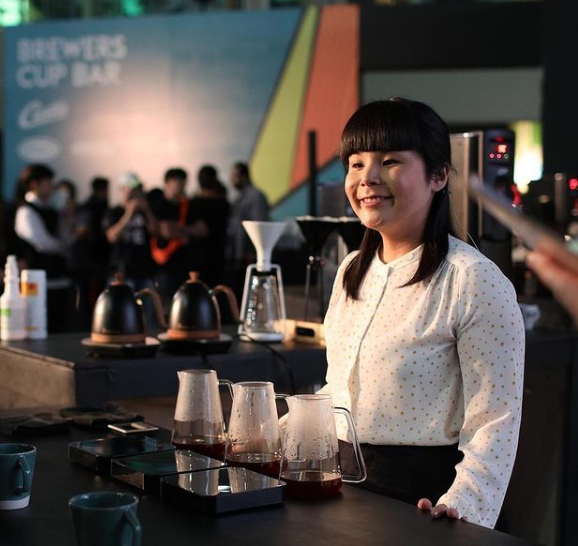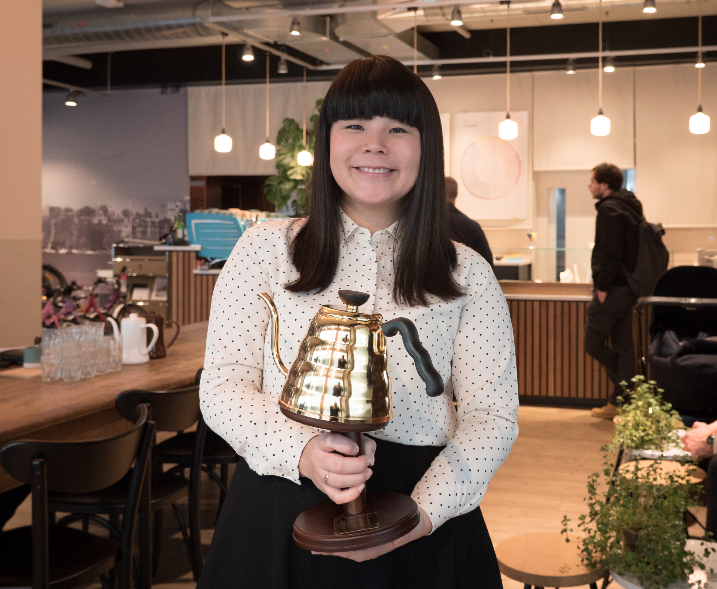Exploration and Experimentation
Getting to know a coffee and helping it reach its full potential. Emi Fukahori, the 2018 World Brewer’s Cup Champion, explores how experimental processing of coffee impacts the flavour characteristics through her winning performance.
Words by Karolina Kumstova

Emi Fukahori is one of Switzerland’s most known baristas and cafe owners. Originally from Japan, the co-owner of MAME in Zurich took the speciality coffee scene in Switzerland by storm since her competition beginnings in 2015. Although Emi did not win in Seattle—her first time on the world stage—she kept on competing every year after, alongside her life and business partner Mathieu Theis (a top-ranking barista himself and 2016, 2018 & 2019 Swiss Barista Champion).
In the years that followed Emi’s first Swiss win, the ambitious competitor went from Barista to Brewers Cup category. She took the third place at the Swiss Barista championship in 2016. Emi kept on working hard though and her efforts brought her third place in the 2017 Swiss Brewers Cup championship. 2018 was going to be Emi’s year.
I asked Emi a few questions to learn in detail about her first time on the World Brewers Cup stage. Emi has done an incredible job as a hard-working and motivated barista and conducted a presentation that wonderfully reflected the current state of the industry.
In order to understand Emi’s presentation, we must first learn about the coffee she used. Emi competed with Laurina, an experimental varietal produced at the Daterra farm in Brazil, as part of their Masterpieces lots. Daterra, which is the first farm to receive the highest sustainability certification (Rainforest Alliance), has been experimenting with this particular coffee for the past twelve years, and the result definitely deserves the attention it is getting now.
We wondered what made Emi choose a Brazilian coffee for her presentation. It is not usually the first choice of a competition coffee in the Brewers Cup category, but her achievement may very well change this trend.
Emi told us: “My life and business partner [Mathieu Theis] was invited by the Daterra farm, as a prize for having placed 3rd at WBC in Amsterdam (2018). He cupped many coffees with their fellow WBC finalists, and he brought 15 coffees back to Zurich. This was my first cupping for WBrC coffee selection, and all of these 15 coffees were extremely beautiful. 4 out of the 15, especially one—Laurina—was so sweet, syrupy and interesting, changing acidities as it cooled. I hadn't tasted Laurina before, so I got curious and wanted to know more.”
Emi decided that she was going to compete with this coffee, although it was a challenging one to work with. Her willingness to work hard was the key to this coffee, and what motivated her was knowing she’d learn a lot in the process.
The story of the Laurina varietal is a story of a previously almost extinct coffee, a Bourbon hybrid originally from the Reunion Islands, and combined processing methods called anaerobic maceration. The seeds can be recognised as ‘pointy’, which gives Laurina its name ‘Bourbon Pointu’.
Emi explained what happens after the harvesting of the cherries: “At Daterra farm, they put ripe, whole cherries of Laurina in a tank and seal it for 48 hours. The tank has a one-way valve, from which O2 gets pushed out by CO2 that was produced during the fermentation happening in the tank. Inside the tank, an anaerobic environment is created in the process. At the bottom of the tank, cherries get crushed by the weight of the cherries above. The cherries in the middle of the tank get squeezed. In the top layer of the tank, cherries get only fermented. This mixture of cherries creates complex acidities [in the final cup]. After 48 hours, cherries get dried on African beds for 20 days. To finish the drying off, they are dried in a tumbler to ensure uniform drying.”
From Daterra, we learn that this processing was actually inspired by the winemakers of Beaujolais, an idea that Daterra gives credits for to Cafe Lomi. It took Daterra six years of experiments with a range of fermentation techniques, and over twelve years of studies of the varietal itself, to finally produce a coffee this way, in 2016.
Emi helped us better understand this coffee by telling us about some of the challenges that the coffee offered her, as well as her practice time in the months coming up to the WBrC in Belo Horizonte.
Laurina was quite a tough nut to crack for several reasons: “Like any coffee, Laurina changed depending on the number of days after being roasted, and based on how it was roasted. Plus, Laurina often behaved unexpectedly. For example, Laurina does not react much to different grind sizes—finer or coarser—the reaction was smaller than other coffees I know. When brewing, the agitation from the outside (using a stirrer) did not change the extraction much. The contact time with water affected the intensity of tastes and the coffee was really reactive to different water temperatures. All these facts did not make my training easy, yet it had been such a learning phase that I was really happy with my choice from the beginning.”
Emi, who is originally from Japan, did not have only Mathieu to help her with her presentation and brewing technique, she was also able to practice with the 2016 World Brewers Cup champion, Tetsu Kasuya. Emi and Tetsu met during the World Coffee Championships in Seattle, in 2015, where he attended as the Japanese AeroPress champion. She was really happy to connect with him in her native language, and a year later, when he became the 2016 World Brewers Cup champion, he also became an inspiration to Emi. Many have since used his V60 pour over technique.
Emi added that she herself used it a lot: “Since I have started competing in Brewers Cup I have always referred to his techniques. Especially for compulsory service, as I did not do well in 2017, I wanted to fix it learning from Tetsu. This year [2018], Tetsu flew to Zurich twice, basically to bounce ideas to brew better and extract better.”
The champion trained at her home base, as well as on the farm. She paid a visit to Daterra before the championships in order to learn as much about Laurina as she could, but also to run the Daterra team through her presentation. She told us: “As I trained at Daterra, I could brew for Isabel Pascoal Becker (the daughter of the owner of Daterra), Gabriel Agrelli Moreira (our contact person) and Edna Dias (one of the quality controllers). It was one of my most emotional moments. I was really happy to brew their beautiful coffee for them, at their farm.”
During the first encounters with Laurina, Emi understood that she will need to combine several methods in her brewing in order to extract the most of her coffee. The method she found the most suitable was the GINA brewer, which she has been familiar with since the opening of the second MAME cafe. There, they brew all of their coffees with Gina.
Emi told us what made the Gina brewers perfect for her coffee: “GINA can be seen as a combination for Hario V60 and Clever Drip. GINA has a valve which allows me to combine the drip and full immersion [methods]. With the valve, the adjustment is really accurate, and the ceramic keeps the brewing temperatures accurately, too. Because of this, and to respect the characters of Laurina, I started to brew [with] GINA thinking how to create a method to highlight Laurina.”

Emi described her coffee to have incredible, delicate flavours, all the while showing no dryness or bitterness in the brews. Watching her WBrC presentation, you will see how excited she was to showcase such a wonderful coffee that is so diverse based on the brew method, the temperature of the brew water, as well as on the temperature of the resulting brew. The coffee constantly changes!
“I believe roasting defines how the coffee can express its characters. Not only the way the coffee is roasted, but also after being roasted, how the coffee ages. My coffee for WBrC 2018 started to shine after 10 days. To choose one roast out of 8 roasts (5 different people roasted for me) for first and final rounds, I made my mind one day before due. It was not about who or how roasted, but I concentrated on how the coffee tasted that timing.”
Emi let her coffee speak for itself and left the information about Laurina’s country of origin only for the last part of her presentation. “I wanted to present a cafe experience to the judges as if it was me and my customers at my cafe.” Revealing that the coffee was, in fact, grown in Brazil, Emi told the judges that their cup is an exciting, smooth, clean, special and juicy cup. It surely was not what the judges expected!
It is almost symbolic that the coffee which won the World Brewers Cup was produced in Brazil, the hosting country of the championship. For many, especially for the hard-working farmers in Brazil, this win speaks for the quality that can be found among Brazilian coffees. It also suggests a step towards a more open-minded stance of the speciality coffee industry when it comes to the origins producing the best coffees in the world.

Laurina varietal has since gained a lot of attention and the carbonic maceration lot sold out during Daterra’s Coffee Auction 2018. It was sold for the highest ever bid in the history of Brazilian coffee, which was a great achievement for Daterra, who spent years developing experimental varietals and lots. Daterra did not hesitate though and donated the full profit from the auction of FREVO to a charity that helps improve education in Brazil. The Educar Foundation charity has worked with Daterra on multiple projects and the farm is now hopeful for even a bigger positive impact of their record-breaking coffee.
What the current champion plans to achieve in the coming months and what are your dreams in coffee were the last questions for Emi, who is not only a competitor and a cafe owner but also a coffee trainer. “We would like to start roasting at MAME and set an academy for home and professional baristas and competitors. Here, we are really looking forward to sharing what we have learnt since we started competing. We also want to stay involved in future championships to learn continuously,” Emi told us.
The 2018 World Brewers Cup champion hopes to “have different opportunities to get to know various coffee scenes in the world, and share what is going with the others.”
“My wish is that people choose to drink coffee with consciousness. If more and more people choose what they enjoy, coffee can be understood to be more than just caffeine. Like good wine or cigars, I wish that coffee can be seen as enjoyment. Even if some people will not be coffee geeks, even a simple coffee can be specialty coffee - for me specialty coffee means coffee with care - there will be better coffee at more places. I wish quality coffee gains more recognition as enjoyment, so that people in coffee (from farm to serving people) feel more responsibility and joy to provide their coffee to people drinking it. If the whole chain moves to quality, there will be better coffee everywhere.”